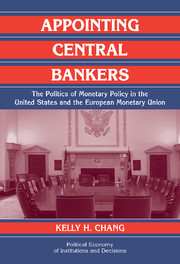 Appointing Central Bankers
Appointing Central Bankers Book contents
- Frontmatter
- Contents
- List of Figures
- List of Tables
- Acknowledgments
- 1 Introduction
- 2 A Formal Model of the Appointment Process
- 3 Estimating Monetary Policy Preferences
- 4 Empirically Testing the Model's Predictions
- 5 Appointments to the European Central Bank
- 6 The Origins of the Federal Reserve Appointment Process
- 7 Conclusions
- Bibliography
- Index
- Titles in the series
5 - Appointments to the European Central Bank
Published online by Cambridge University Press: 05 September 2009
- Frontmatter
- Contents
- List of Figures
- List of Tables
- Acknowledgments
- 1 Introduction
- 2 A Formal Model of the Appointment Process
- 3 Estimating Monetary Policy Preferences
- 4 Empirically Testing the Model's Predictions
- 5 Appointments to the European Central Bank
- 6 The Origins of the Federal Reserve Appointment Process
- 7 Conclusions
- Bibliography
- Index
- Titles in the series
Summary
Italy's membership in the EMU was unthinkable in early 1996. At that time, Italy fulfilled none of the Maastricht convergence criteria, a number of economic requirements for entry into the EMU. Among European Union (EU) countries, with the exception of Greece, Italy's budget deficit, inflation rate, and interest rates were the highest, and its gross debt was the second highest. In addition, the Italian lira left the Exchange Rate Mechanism (ERM) in 1992.
Within months, the situation changed drastically. In the fall, Italy released its budget forecasts for 1997 and 1998 (Financial Times, September 28, 1996). Surprisingly, the deficit figures nearly achieved the 3 percent convergence criterion level, which raised expectations of Italy's entrance into EMU. Consequently, the Italian inflation and interest rates began to drop, and Italy rejoined the ERM (Financial Times, November 25, 1996). Combined with the fact that the German and French budgets indicated problems with the 3 percent level and that the Belgian gross debt was even higher than the Italian debt, Italy's prospects looked markedly better.
Still, the core EMU countries forcefully raised concerns about Italy's economic fitness for EMU entry. French president Jacques Chirac stated that Italy needed to get its financial house in order and that, “[joining EMU] may take a little bit longer for those who are further behind, like Italy” (Financial Times, October 2, 1996). Hans Tietmeyer, president of the German Bundesbank, proclaimed, “Italy certainly has more to do” (Financial Times, November 29, 1996).
- Type
- Chapter
- Information
- Appointing Central BankersThe Politics of Monetary Policy in the United States and the European Monetary Union, pp. 91 - 115Publisher: Cambridge University PressPrint publication year: 2003
